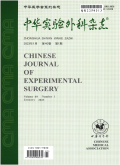低频电刺激促进周围神经损伤后再生和修复的研究
Effect of electrical stimulation on regeneration and repair of injured peripheral nerves
摘要目的:探讨低频电刺激促进周围神经损伤(PNI)后再生和修复的效果。方法:随机选取体重为200~220 g的健康雄性SD大鼠64只(武汉大学动物实验中心采购:维通利华),制备大鼠坐骨神经钳夹损伤模型,然后随机分为两组,实验组进行电刺激治疗12周,对照组不予治疗;采用坐骨神经电生理、神经行为学和透射电镜等评估电刺激治疗对大鼠坐骨神经损伤后再生和功能恢复情况。两独立样本采用 t检验。 结果:随着治疗时间延长,两组大鼠实验组坐骨神经功能指数测定(SFI)及运动神经传导速度(MNCV)逐渐升高。与对照组比较,实验组实验组大鼠SFI在治疗4、8、12周时分别为-52.73±1.53比-68.43±0.99、-20.77±0.95比-43.57+1.14、-5.92±0.44比-24.68±0.63,差异有统计学意义( t4周=24.327, t8周=43.340, t12周=68.998, P<0.05);实验组大鼠和MNCV在治疗4、8、12周时分别为(36.43±0.66) m/s比(24.44±0.51) m/s、(48.87±0.27) m/s比(39.38±0.57) m/s、(55.51±0.51) m/s比(44.45±0.36) m/s,差异有统计学意义( t4周=40.342, t8周=42.423, t12周=50.249, P<0.05);在治疗12周后,与对照组比较,实验组大鼠坐骨神经纤维数量为(20 707.25±227.36) fb/mm 2比(19 141.25±173.43) fb/mm 2( t=15.489, P<0.01),神经纤维直径为(3.81±0.09) μm比(3.35±0.06) μm( t=12.204, P<0.05),差异均有统计学意义。 结论:低频电刺激可有效促进周围神经损伤后的再生及修复。
更多相关知识
abstractsObjective:To investigate the effect of electrical stimulation on regeneration and repair of injured peripheral nerves.Methods:Sixty-four healthy male SD rats weighing 200-220 g were randomly selected, and the sciatic nerve clamp injury model was established. The animals were divided into two groups. The experimental group was treated with electrical stimulation for 12 weeks, and the control group was not treated. Objective indexes such as electrophysiology, neuroethology and transmission electron microscopy were used to evaluate the regeneration and functional recovery of sciatic nerves after electrical stimulation.Results:With the prolongation of the treatment, the sciatic function index (SFI) and motor nerve conduction velocity (MNCV) in the experimental group increased gradually. Compared with the control group, the SFI in the experimental group was -52.73±1.53 vs. -68.43±0.99, -20.77±0.95 vs. -43.57±1.14, -5.92±0.44 vs. -24.68±0.63 at 4, 8 and 12 weeks after treatment, respectively. The differences were statistically significant ( t4 W=24.327, t8 W=43.340, t12 W=68.998, P<0.05). The MNCV in the experimental group was (36.43±0.66) m/s vs. (24.44±0.51) m/s, (48.87±0.27) m/s vs. (39.38±0.57) m/s, (55.51±0.51) m/s vs. (44.45±0.36) m/s at 4, 8 and 12 weeks after treatment, respectively. The differences were statistically significant ( t4 W=40.342, t8 W=42.423, t12 W=50.249, P<0.05). Compared with the control group, the number of sciatic nerve fibers in the experimental group was (20 707.25±227.36) fb/mm 2 vs. (19 141.25±173.43) fb/mm 2 ( t=15.489, P<0.01), and the diameter of nerve fibers was (3.81±0.09) μm vs. (3.35±0.06) μm ( t=12.204, P<0.05) at 12th week after the treatment. Conclusion:Electrical stimulation can effectively promote the regeneration and repair of peripheral nerves after injury.
More相关知识
- 浏览0
- 被引15
- 下载0


相似文献
- 中文期刊
- 外文期刊
- 学位论文
- 会议论文



 换一批
换一批 换一批
换一批



